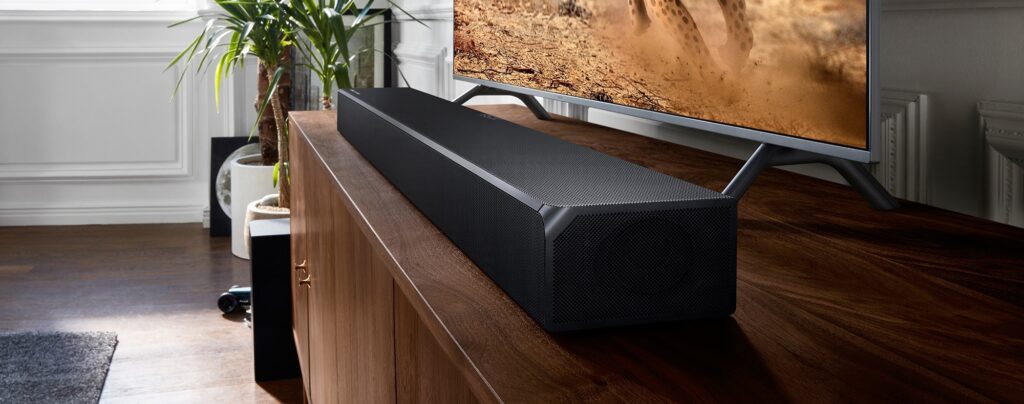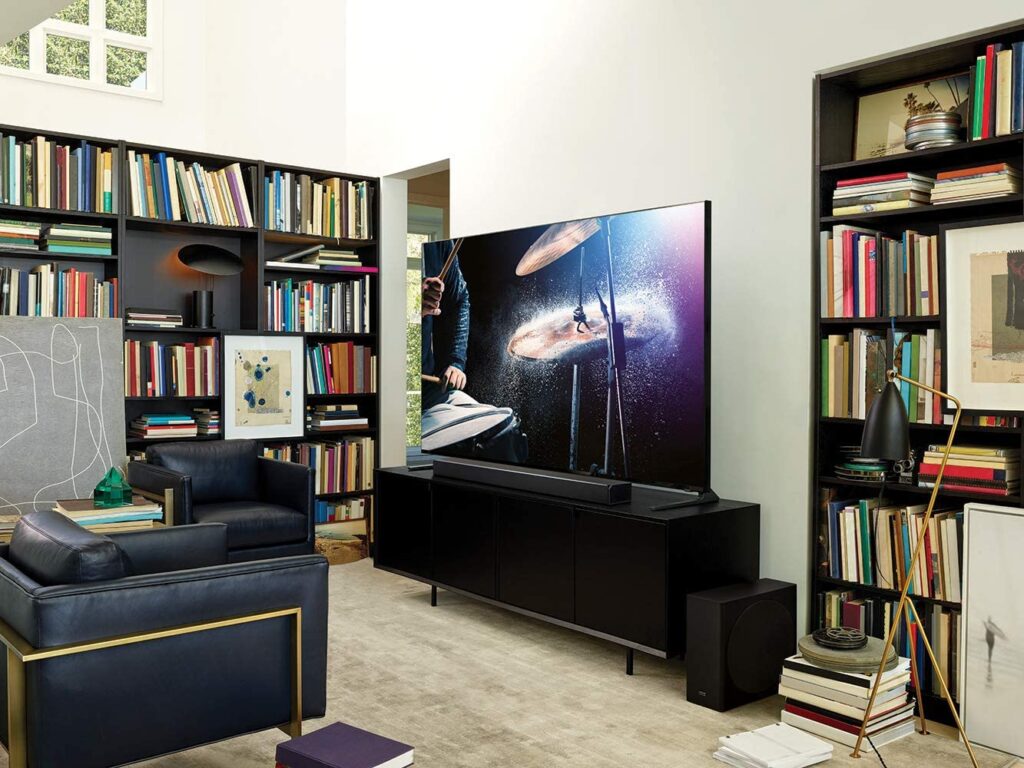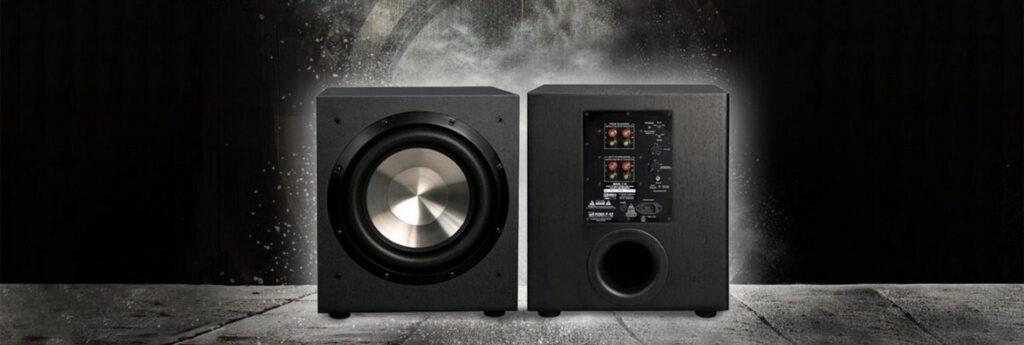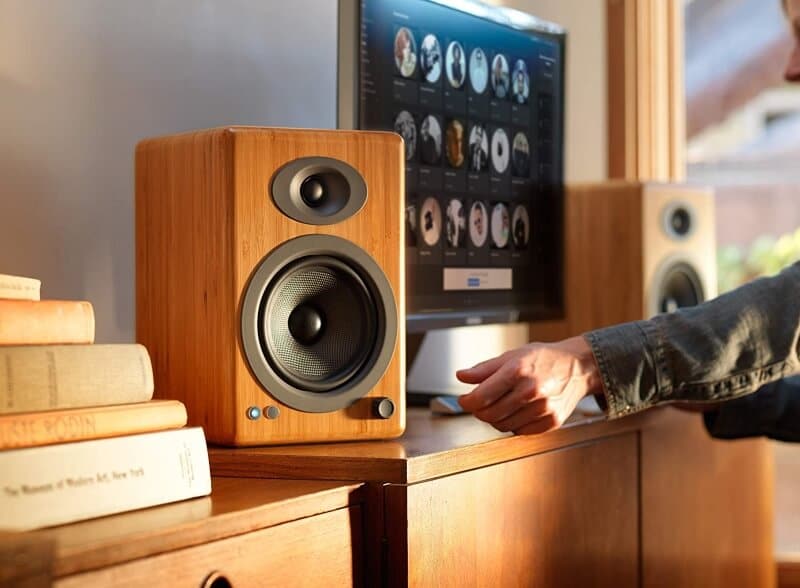If you’re a fan of high-quality audio, then you’ll know the importance of a great subwoofer. It can dramatically improve the quality of the sound and give you that full bass experience.
Loudspeakers in home sound systems usually can’t pick up low-level bass without the help of a subwoofer. The use of subwoofers Trusted Source Subwoofer - Wikipedia A subwoofer (or sub) is a loudspeaker designed to reproduce low-pitched audio frequencies known as bass and sub-bass, lower in frequency than those which can be (optimally) generated by a woofer. en.wikipedia.org is one of the basic requirements for a high-quality home theater experience. If you have a vintage set-up, then you may be wondering how to connect a subwoofer to an old amplifier.
Connecting the right sub and amplifier makes a huge difference in your experience without the cost of a brand new home theater system. And if you already have an amplifier or receiver, this will cost you even less. There are several ways to connect a subwoofer to an old amplifier, and here we’ll show you how. Let’s find out!
When it comes to subwoofers of home stereo systems, they can be powered/active and non-powered/passive. Powered subs use a low signal boosted by a built-in speaker amplifier, power supply, and crossover.
They are one of the most commonly utilized ones and use an RCA-type input jack to connect to the receiver. On the other hand, passive subs are simply a subwoofer speaker inside the bass enclosure. This is directly wired to the speakers or a bass crossover inside. These are less common.
Subwoofers can be front-firing, with the main driver facing forward, or down-firing, with a driver on the bottom of the subwoofer. The front-firing subwoofer works best when placed closer to the main speakers. Speed, clarity, precise intonation of individual tones are all-important requirements in a stereo sound system. Forward-firing drivers produce all these far better than the down-firing ones. The result will be a bass that sounds fast and impactful.
Subwoofers with ports leading directly to the interior are known as ported subwoofers. Subs without any ports are called sealed subwoofers. The most frequently used subwoofers are sealed, mostly because they are more affordable than the ported ones. Besides the price factor, the difference between them also lies in sound quality. Sealed subs have an even, controlled sound quality, while ported subwoofers can emit higher volume. Sealed subwoofers are perfect for home theaters as they will make the sound more enjoyable in a smaller space.
Most subwoofers will need to be connected directly to a wall outlet for power and to your amplifier with an RCA cable, so they can receive sound. Wireless subs are a lot more expensive and often work only with sound systems from the same manufacturer. Subwoofers can differ in many other things like their overall sound quality, power (wattage), frequency range, equalization, or connectivity.
If you are looking for a new subwoofer, then there are some brilliant subwoofers for under $1,000. If you were on more of a budget, then you can also look for the best subwoofers under $500 as you can still get some wonderful deals here.
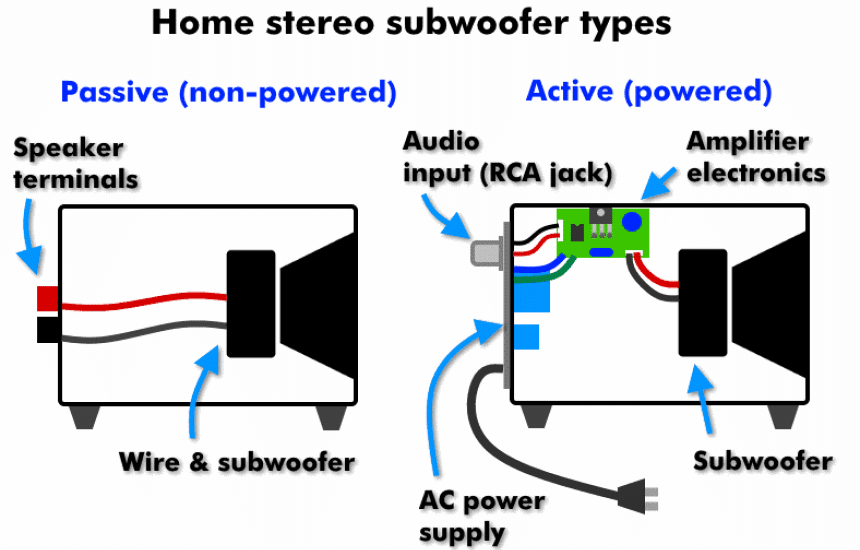 How Do They Work?
How Do They Work?A subwoofer is essentially a loudspeaker that reproduces low-frequency audio, such as bass and sub-bass. Subs consist of one or more woofers placed in an enclosure, usually made of good quality wood capable of withstanding pressure and resisting deformation. Unlike regular speakers, which can reproduce a wide range of frequencies but lack the bass, subwoofers can even pick up frequencies that are inaudible to the human ear.
High-quality subs can go low as 15-16 Hz, while we can only hear down to 20 Hz. Subwoofers are never used only by themselves since their purpose is to expand the range of loudspeakers, which cover the higher frequency bands.
Subwoofers are connected to an audio receiver or amplifier. The receiver sends low-frequency signals via an electrical current to the subwoofer. This frequency ranges between 20 Hz and 100 Hz, and the lower your sub goes, the better will you hear the bass sound effects.
The subwoofer then amplifies this current and converts it to a sound frequency through a magnetic coil that causes the driver to vibrate. This vibration results in the correct sound waves leaving the driver through its output.
As these low, bass, or sub-bass signals are not directional the way higher frequencies are, the user can place the subwoofer anywhere they want to. With a subwoofer, the sound works best as it deflects off something. When the sub is on, you won’t be able to tell where it’s placed and from which direction the bass is coming. You can play with positioning your sub until you find the best location for the sound quality you want to achieve.
In passive subs, a crossover in the signal path removes the bass from the signals driving the main speakers, filtering it. Subwoofers that extend bass without filtering won’t boost up the power of the main speakers either. The crossover at the powered subwoofers is already built-in and adjustable to let you select the frequency. This makes the integration with the main speakers easier and the line-level output filtering automatic.
Sound has three layers to it, low, mid and high, registered as frequencies. For example, a bass guitar or drum emits a low-frequency bass note, middle frequencies usually come from a singer’s voice or a guitar, while the higher frequency sounds like other instruments with a ringing or clashing sound. Subs help de-clutter the speaker by separating the low sounds from the mids and highs.
If you wanted a great example of a high-quality subwoofer, then you can take a look at the SVS PB-1000, which strikes the perfect balance between quality, durability, and affordability. There are many great subwoofers out there that can make a huge difference to your home theater experience.
As you are considering using a subwoofer along with an amplifier, you are probably also wondering if it works better with an older amp or a new technology. The answer to that is not exactly a simple one. The quality of the sound the subwoofer with an amplifier produces depends on various factors. For example, if you already have an old, functioning receiver, you will probably want to make it work. And you will most likely be able to connect it to the sub, but the sound quality may be lower than expected.
You can also buy amps as new or as vintage. The older ones will undoubtedly be easier on your budget, as you can come by them at any thrift store or even garage sale. There’s also some nostalgia that comes from connecting a subwoofer to a vintage amp.
When you buy any used item, though, there’s always the potential for there to be an issue. With an amplifier, the older it is, this will most likely happen, so make sure you inspect the amp before buying. If it does have an issue, then make sure it can be repaired. While modern receivers can cost you ten times more, the chances of any preexisting damage are far less, plus they often come with a manufacturer’s warranty.
Vintage amplifiers have an advantage over modern ones in terms of durability and service. You can take a vintage amp to a service or repair it yourself by changing out components like capacitors, resistors, diodes, transistors, or failed circuits. Vintage receivers rarely need repairing because they were designed to last for a long time. This is not the case with most modern receivers unless they are in a really high-end price category. When a newer amp dies, you will probably need to replace it instead of repairing it.
The choice between old and new could also depend on how you intend to use the amplifier. Most older amps have inputs labeled tuner, tape deck, aux, and phono. The first three are line-level inputs and are used for a CD player or an MP3 player. The phono output is only for older models, as it was used for turntables. It’s not a line-level output, so the cartridge signal needs to go through a phono preamp to be amplified and lined. With the increased use of CD players, modern amp manufacturers rarely put a phono preamp in their amps.
To get the most of your sound system, you need to direct the right signals, beginning from a speaker-level to the amplifier or receiver and ending with the connected subwoofer. Subwoofers are relatively easy to install, so you will probably need only one cable for power and one for the amplifier. The main difference in connectivity comes from the input and output types of the amp or the sub. For the signal to reach the amp, use the cable that comes with the subwoofer and connect your amps subwoofer output to the LFE (low-frequency effect) input on the subwoofer. If your amp doesn’t have an LFE subwoofer output or LFE input, as is often the case with old amplifiers, try to connect the two with an RCA cable.
Home theaters and some home stereo receivers usually have an LFE subwoofer output, and it’s usually labeled as such. This ensures that the signal that goes through is bass-only, meaning it needs a subwoofer. Connecting the subwoofer to an old amplifier this way requires connecting the LFE jack on the amplifier to the LFE In jack on the subwoofer. This is usually a cable with single RCA connectors on both ends. If your subwoofer model has divided right and left stereo RCA connectors, simply plug in the amplifier using an RCA cable that’s split on one end. After that, plug in the cord to both the left and right ports on the subwoofer.
Some older subwoofer models use spring clips to connect speakers, and here you will need to use the speaker output of the receiver to make the connection. If the sub has two sets of clips, one will be for the speaker, the other for the receiver. This way, the speakers and the receiver are connected to the sub separately. If the subwoofer has only one set of clips, the subwoofer will have the same receiver connection as the speakers.
To control the volume of your subwoofer, you need to do two things. First, you need to set up a crossover, which is the frequency where your subwoofer starts playing bass notes. The next step is to adjust the volume by playing a sound, turning the subwoofer down until you can’t hear it, then turning it back up until you can just start to register the bass. Both the crossover and the volume and be adjusted by controlling the nobs on the sub.
After adjusting the volume of your subwoofer, check out the best way to place it. One of the most important things when setting up a subwoofer is to set the proper distances between the sub and the speakers. If you have more than one speaker, measure the distance between them to avoid oscillations in bass levels. To save time, follow the manufacturer’s instructions on how to auto-calibrate your sound system.
The ideal place for it is in front of speakers, or if you don’t have a space for it, try to put it as near as possible. Although the perfect set-up always depends on how you intend to use your sub and with what equipment. For example, with a stereo or computer system, the bass volume should be set in such that it sounds the best from the place you usually sit. The same is true for the subwoofer placement. Listen to a bass sound, find the place where it sounds perfect concerning your usual position, and then put your sub there.
Receivers in home theater systems have room correction systems that adapt the sounds to your surroundings. If your subwoofer is connected to a home theater receiver, set the subwoofer’s crossover frequency to the maximum and use the receiver’s subwoofer settings for crossover set-up. However, if your home cinema is located in a larger room, you might need another subwoofer. This will give you the best bass experience by evenly distributing it in a large space.
Subwoofers can be used with small powered speakers too. If these have stereo output, adjust the crossover on your subwoofer. In case your powered speakers have a subwoofer output with a filter on it at the right frequency, set the crossover on the subwoofer to a bypass mode to avoid doubling the bass filter.
If all that sounds a little complicated, then you can make your life easier by getting one of the best soundbars, which is a great alternative and one that requires minimal technical knowledge. You can also avoid the installation fuss if you go for a high-end soundbar, such as the VIZIO SB3651-F6.
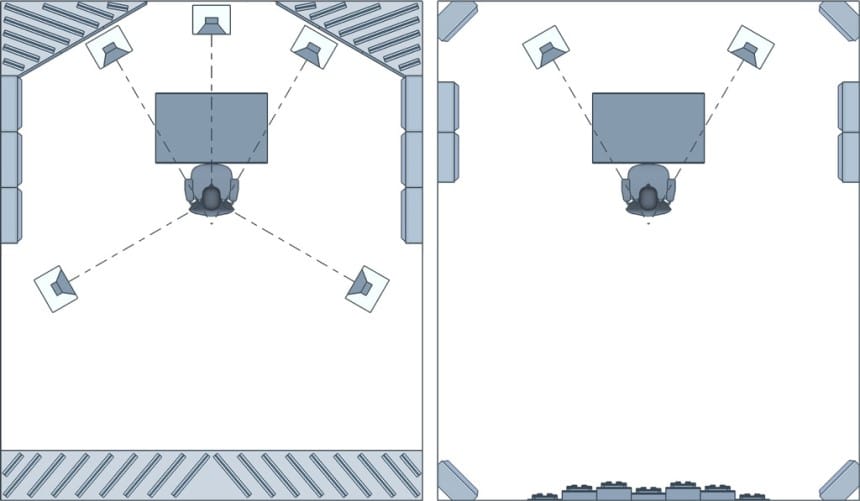
Surround systems can separate the dedicated bass sound from a DVD or other media and send it through a subwoofer. If you enjoy watching a movie with a full bass experience, using a receiver without a sub output might leave you fell robbed. To avoid this, use a receiver that has both surround and stereo mode. Because in stereo mode, all amplifiers connected to subwoofers have the same effects, old or new.
Another difference between stereo and surround sound is that while stereo does create a stage effect to the sound. Surround sound does the same, but it can place sounds wherever you want them to come from. In a home theater, stereo sound uses two speakers to produce sound, the front left and the front right. On the other hand, surround sound uses five to seven speakers of your cinema system. This is one more reason to get a surround system for watching movies in a home cinema center or for a practice room for professional musicians and gamers.
If you buy an audio system for occasionally listening to music, then a stereo audio system should be enough. In this case, even an old amplifier will do the job. Particularly in a small room, where only compact size speakers can be placed. Since music is already recorded for playback in stereo systems, listening to it in stereo mode is more enjoyable. Not to mention affordable, as most playback devices have stereo systems.
Hopefully, now you have a clear idea of how to hook up a subwoofer to an old amplifier. In most cases, subwoofers can be connected to any amplifier, and the process is usually fairly simple.
Besides the awesome bass or even sub-bass frequencies, a sub can make you enjoy sounds on a whole new level. Once you connect it to an amplifier or receiver, it can bring your home theater system to life.
Older amplifiers can be a perfect fit for people with simple needs and a lower budget. Knowing how to connect a subwoofer to an old amplifier will allow you to instantly get the audio quality you’re looking for. All that’s left to do is hook up your sub to your old amp. Good luck!
